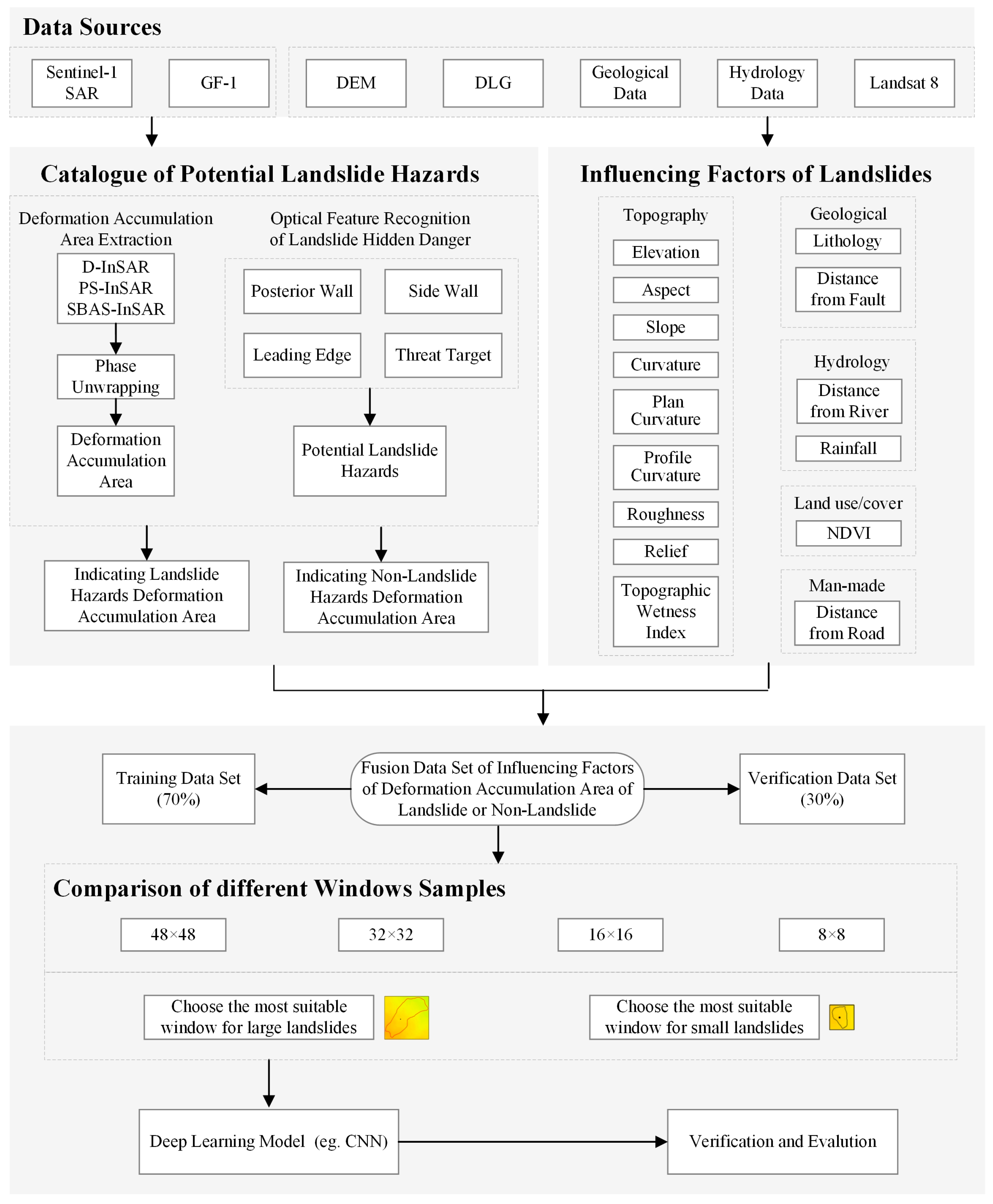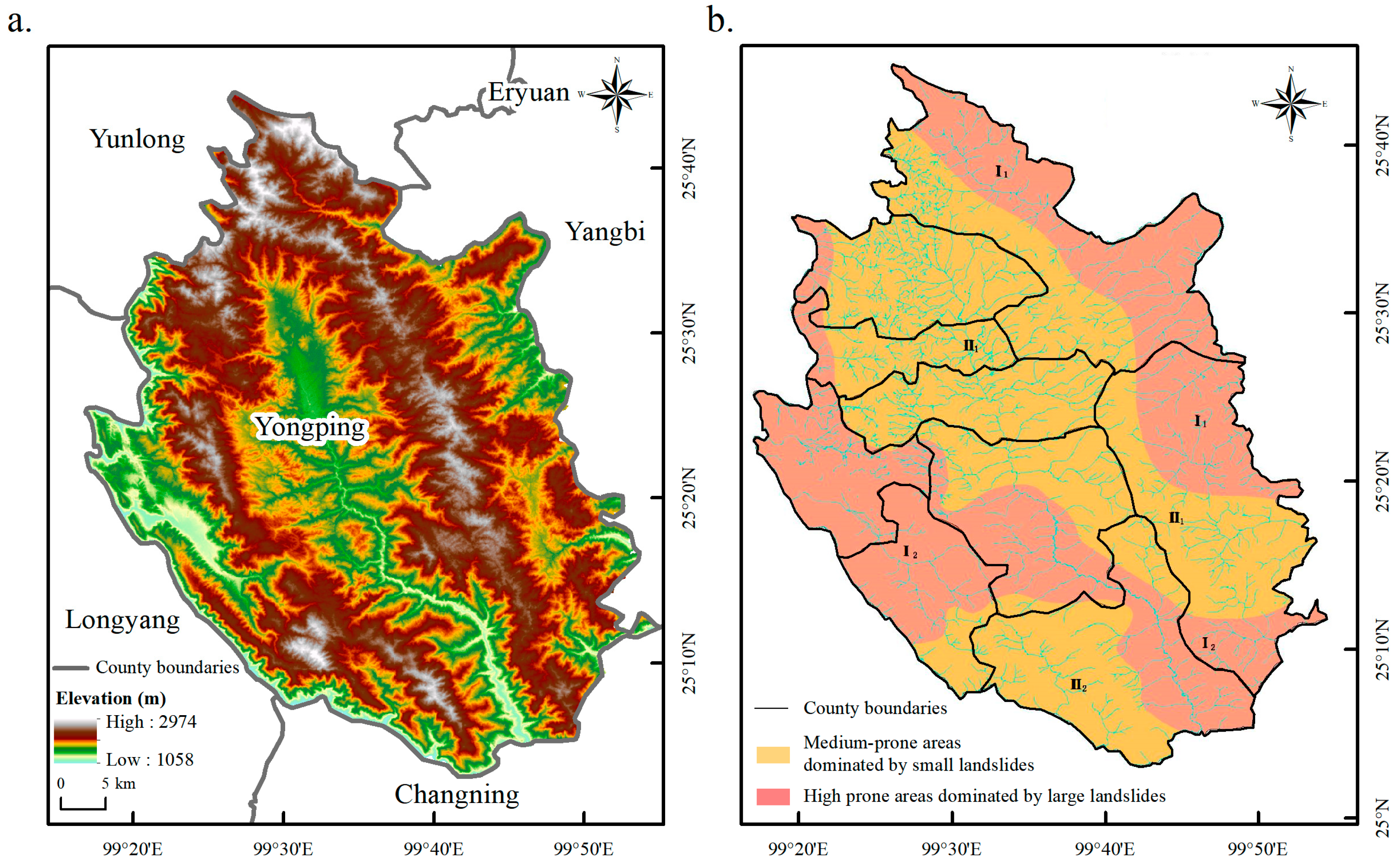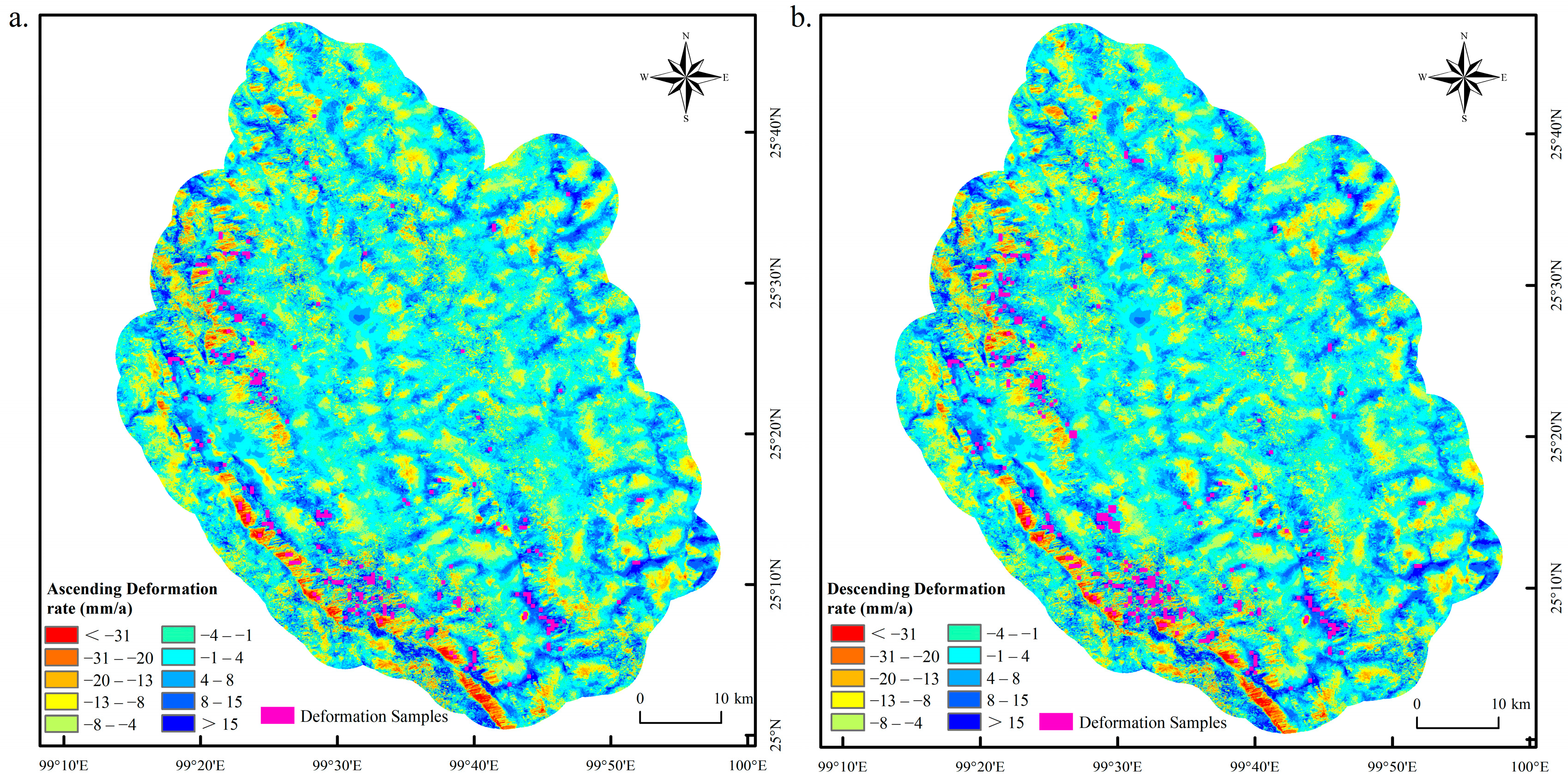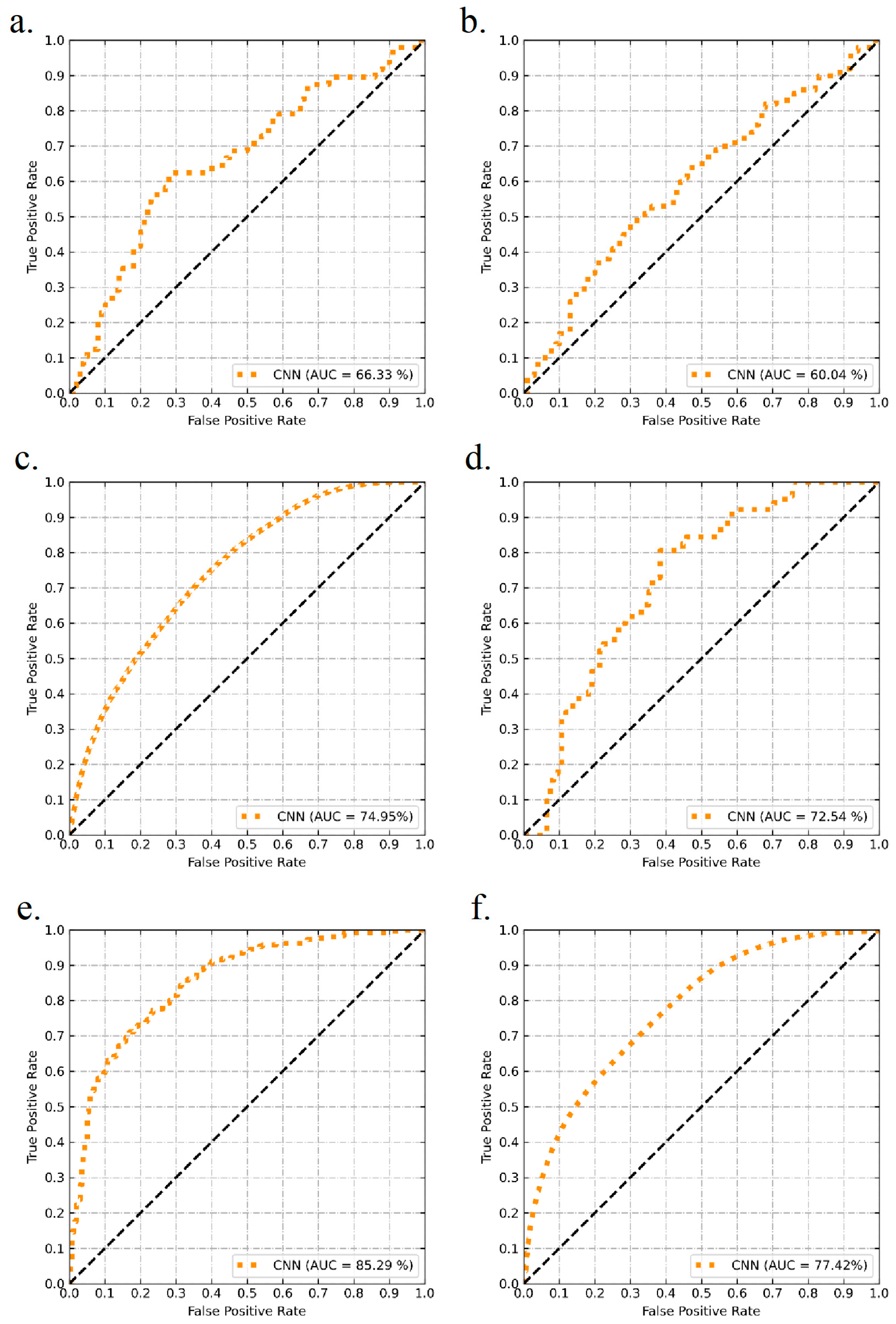Multi-Window Identification of Landslide Hazards Based on InSAR Technology and Factors Predisposing to Disasters
Abstract
1. Introduction
2. Methodologies
2.1. Data Processing Flow
2.2. Landslide Hazard Identification Based on InSAR Technology
2.3. Multi-Window Screening of Landslide Hazards Supplemented by Geographical Factors
3. Study Area and Data
3.1. Study Area
3.2. Data and Preprocessing
4. Results and Discussion
4.1. InSAR Deformation Treatment Results
4.2. Multi-Window Identification Results of Landslide Hazards
5. Conclusions
Author Contributions
Funding
Data Availability Statement
Conflicts of Interest
References
- Scaioni, M.; Longoni, L.; Melillo, V.; Papini, M. Remote sensing for landslide investigations: An overview of recent achievements and perspectives. Remote Sens. 2014, 6, 9600–9652. [Google Scholar] [CrossRef]
- Liu, X.; Miao, C. Large-scale assessment of landslide hazard, vulnerability and risk in China. Nat. Hazards Risk 2018, 9, 1037–1052. [Google Scholar] [CrossRef]
- Zhao, C.; Lu, Z. Remote sensing of landslides—A review. Remote Sens. 2018, 10, 279. [Google Scholar] [CrossRef]
- Lissak, C.; Bartsch, A.; De Michele, M.; Gomez, C.; Maquaire, O.; Raucoules, D.; Roulland, T. Remote sensing for assessing landslides and associated hazards. Surv. Geophys. 2020, 41, 1391–1435. [Google Scholar] [CrossRef]
- Zheng, X.; He, G.; Wang, S.; Wang, Y.; Wang, G.; Yang, Z.; Yu, J.; Wang, N. Comparison of machine learning methods for potential active landslide hazards identification with multi-source data. ISPRS Int. J. Geo-Inf. 2021, 10, 253. [Google Scholar] [CrossRef]
- Tien Bui, D.; Shahabi, H.; Shirzadi, A.; Chapi, K.; Alizadeh, M.; Chen, W.; Mohammadi, A.; Ahmad, B.B.; Panahi, M.; Hong, H.; et al. Landslide detection and susceptibility mapping by airsar data using support vector machine and index of entropy models in cameron highlands, malaysia. Remote Sens. 2018, 10, 1527. [Google Scholar] [CrossRef]
- Liu, Y.; Lu, Z.; Zhao, C.; Kim, J.; Zhang, Q.; de la Fuente, J. Characterization of the kinematics of three bears landslide in Northern California using L-band InSAR observations. Remote Sens. 2019, 11, 2726. [Google Scholar] [CrossRef]
- Zhou, C.; Cao, Y.; Hu, X.; Yin, K.; Wang, Y.; Catani, F. Enhanced dynamic landslide hazard mapping using MT-InSAR method in the Three Gorges Reservoir Area. Landslides 2022, 19, 1585–1597. [Google Scholar] [CrossRef]
- Dong, J.; Zhang, L.; Tang, M.; Liao, M.; Xu, Q.; Gong, J.; Ao, M. Mapping landslide surface displacements with time series SAR interferometry by combining persistent and distributed scatterers: A case study of Jiaju landslide in Danba, China. Remote Sens. Environ. 2018, 205, 180–198. [Google Scholar] [CrossRef]
- Dong, J.H.; Niu, R.Q.; Qi, M.R.; Ding, Z.; Xu, H.; He, R. Identification of geological hazards based on the combination of InSAR technology and disaster background indicators. Bull. Geol. Sci. Technol. 2022, 41, 187–196. [Google Scholar] [CrossRef]
- Osmanoğlu, B.; Sunar, F.; Wdowinski, S.; Cabral-Cano, E. Time series analysis of InSAR data: Methods and trends. ISPRS J. Photogramm. Remote. Sens. 2016, 115, 90–102. [Google Scholar] [CrossRef]
- Rongier, G.; Rude, C.; Herring, T.; Pankratius, V. Generative modeling of InSAR interferograms. Earth Space Sci. 2019, 6, 2671–2683. [Google Scholar] [CrossRef] [PubMed]
- Shi, X.; Liao, M.; Li, M.; Zhang, L.; Cunningham, C. Wide-area landslide deformation mapping with multi-path ALOS PALSAR data stacks: A case study of Three Gorges Area, China. Remote Sens. 2016, 8, 149. [Google Scholar] [CrossRef]
- Rosi, A.; Tofani, V.; Tanteri, L.; Stefanelli, C.T.; Agostini, A.; Catani, F.; Casagli, N. The new landslide inventory of Tuscany (Italy) updated with PS-InSAR: Geomorphological features and landslide distribution. Landslides Landslides 2018, 15, 5–19. [Google Scholar] [CrossRef]
- Zhang, Y.; Meng, X.; Dijkstra, T.; Jordan, C.; Chen, G.; Zeng, R.; Novellino, A. Forecasting the magnitude of potential landslides based on InSAR techniques. Remote. Sens. Environ. 2020, 241, 111738. [Google Scholar] [CrossRef]
- Ge, D.Q.; Dai, K.R.; Guo, Z.C.; Li, Z.H. Early Identification of Serious Geological Hazards with Integrated Remote Sensing Technologies: Thoughts and Recommendations. Geomat. Inf. Sci. Wuhan Univ. 2019, 44, 949–956. [Google Scholar] [CrossRef]
- He, K.; Li, B.; Zhao, C.Y.; Gao, Y.; Chen, L.Q.; Liu., P.F. Identification of large-scale landslide hazards based on differences of geological structure prone to sliding and multiple-source data in karstmountainous areas. Carsologica Sin. 2020, 39, 467–477. [Google Scholar] [CrossRef]
- Ding, A.Z.; Zhang, Q.Y.; Zhou, X.M.; Dai, B.C. Automatic recognition of landslide based on CNN and texture change detection. In Proceedings of the Youth Academic Annual Conference of Chinese Association of Automation (YAC), Wuhan, China, 11–13 November 2016; pp. 444–448. [Google Scholar] [CrossRef]
- Feng, G.C. InSAR National 40 m Resolution Deformation A Map. 2022. Available online: https://engine.piesat.cn/live-detail?id=610&type=1 (accessed on 12 December 2022).
- Zhu, Y.F.; Yao, X.; Yao, L.H.; Yao, C.C. Detection and characterization of active landslides with multisource SAR data and remote sensing in western Guizhou, China. Nat. Hazards 2022, 111, 973–994. [Google Scholar] [CrossRef]
- Ju, Y.Z.; Xu, Q.; Jin, S.C.; Li, W.L.; Dong, X.J.; Guo, Q.H. Automatic Object Detection of Loess Landslide Based on Deep Learning. Geomat. Inf. Sci. Wuhan Univ. 2020, 45, 1747–1755. [Google Scholar] [CrossRef]
- Qi, W.W.; Wei, M.F.; Yang, W.T.; Xu, C.; Ma, C. Automatic mapping of landslides by the ResU-net. Remote Sens. 2020, 12, 2487. [Google Scholar] [CrossRef]
- Sameen, M.I.; Pradhan, B.; Lee, S. Application of convolutional neural networks featuring Bayesian optimization for landslide susceptibility assessment. Catena 2020, 186, 104249. [Google Scholar] [CrossRef]
- Wang, Y.; Fang, Z.; Hong, H.Y. Comparison of convolutional neural networks for landslide susceptibility mapping in Yanshan County, China. Sci. Total. Environ. 2019, 666, 975–993. [Google Scholar] [CrossRef]
- Yang, X.; Liu, R.; Yang, M.; Chen, J.; Liu, T.; Yang, Y.; Chen, W.; Wang, Y. Incorporating landslide spatial information and correlated features among conditioning factors for landslide susceptibility mapping. Remote Sens. 2021, 13, 2166. [Google Scholar] [CrossRef]
- Huang, W.B.; Ding, M.T.; Wang, D.; Jiang, L.W.; Li, Z.H. Evaluation of Landslide Susceptibility Based on Layer Adaptive Weighted Convolutional Neural Network Model along Sichuan-Tibet Traffic Corridor. Earth Sci. 2022, 47, 2015–2030. [Google Scholar] [CrossRef]
- Nikoobakht, S.; Azarafza, M.; Akgün, H.; Derakhshani, R. Landslide Susceptibility Assessment by Using Convolutional Neural Network. Appl. Sci. 2022, 12, 5992. [Google Scholar] [CrossRef]
- Song, F.B. Research on Convolutional Neural Network Modeling and Its Application; North China Electric Power University: Beijing, China, 2021. [Google Scholar] [CrossRef]
- Yongping County People’s Government Office. Yongping Overview. 2022. Available online: http://www.ypx.gov.cn/ypxrmzf/c102483/zjyp.shtml (accessed on 12 December 2022).
- Baidu Encyclopedia. Yongping County. 2022. Available online: https://baike.baidu.com/item/%E6%B0%B8%E5%B9%B3%E5%8E%BF/3556662?fr=aladdin (accessed on 12 December 2022).
- Pourghasemi, H.R.; Yansari, Z.T.; Panagos, P.; Pradhan, B. Analysis and evaluation of landslide susceptibility: A review on articles published during 2005–2016 (periods of 2005–2012 and 2013–2016). Arab. J. Geosci. 2018, 11, 193. [Google Scholar] [CrossRef]
- Wang, S.B.; Zhuang, J.Q.; Zheng, J.; Mou, J.Q.; Wang, Y.; Fu, Y.T. Landslide susceptibility evaluation based on deep learning along kangding-litang section of cz railway. J. Eng. Geol. 2022, 30, 908–919. [Google Scholar] [CrossRef]
- Li, W.B.; Fan, X.M.; Huang, F.M.; Chen, W.; Hong, H.Y.; Huang, J.S.; Guo, Z.Z. Uncertainties analysis of collapse susceptibility prediction based on remote sensing and GIS: Influences of different data-based models and connections between collapses and environmental factors. Remote. Sens. 2020, 12, 4134. [Google Scholar] [CrossRef]
- Sahin, E.K.; Colkesen, I.; Acmali, S.S.; Akgun, A.; Aydinoglu, A.C. Developing comprehensive geocomputation tools for landslide susceptibility mapping: LSM tool pack. Comput. Geosci. 2020, 144, 104592. [Google Scholar] [CrossRef]
- Zhang, X.; Yin, W.P.; Xie, F.; Fan, H.; Chen, F. Habitat suitability evaluation of Asian elephants in the Yuanjiang-Lixianjiang River Basin based on meta-analysis and remote sensing big data. Acta Ecol. Sin. 2022, 42, 5067–5078. [Google Scholar] [CrossRef]
- Zhang, T.Y.; Li, Y.N.; Wang, T.; Wang, H.Y.; Chen, T.Q.; Sun, Z.H.; Luo, D.; Li, C.; Han, L. Evaluation of different machine learning models and novel deep learning-based algorithm for landslide susceptibility mapping. Geosci. Lett. 2022, 9, 26. [Google Scholar] [CrossRef]
- Shorten, C.; Khoshgoftaar, T.M. A survey on image data augmentation for deep learning. J. Big Data 2019, 6, 60. [Google Scholar] [CrossRef]







| Factor | Source | Factor | Source |
|---|---|---|---|
| Lithology | https://geocloud.cgs.gov.cn/ (accessed on 1 December 2022) | Aspect | 30 m SRTM DEM |
| Distance from faults | https://geocloud.cgs.gov.cn/ (accessed on 1 December 2022) | Slope | |
| Rainfall | https://gpm.nasa.gov/ (accessed on 1 December 2022) | Curvature | |
| NDVI | Landsat OLI 30 m | Plane curvature | |
| Distance from road | https://www.webmap.cn (accessed on 1 December 2022) | Profile curvature | |
| Distance from river | https://www.webmap.cn (accessed on 1 December 2022) | Roughness | |
| DEM | https://dwtkns.com/srtm30m/ (accessed on 1 December 2022) | Relief | |
| TWI |
| NO. | Threshold Range (mm/a) | Area (km2) | Percentage (%) | Characteristics Reflect |
|---|---|---|---|---|
| 1 | <−31 | 7.14 | 0.26 | subsidence |
| 2 | −31~−20 | 24.42 | 0.88 | subsidence |
| 3 | −20~−13 | 71.98 | 2.58 | subsidence |
| 4 | −13~−8 | 192.52 | 6.9 | subsidence |
| 5 | −8~−4 | 421.04 | 15.09 | subsidence |
| 6 | −4~−1 | 501.01 | 17.96 | subsidence |
| 7 | −1~4 | 894.4 | 32.06 | subsidence/uplift |
| 8 | 4~8 | 399.14 | 14.31 | uplift |
| 9 | 8~15 | 226.95 | 8.14 | uplift |
| 10 | >15 | 50.83 | 1.82 | uplift |
| Indicator | Value of the Ascending Result | Value of the Descending Result |
|---|---|---|
| Skewness | 1.204 | 1.246 |
| Skewness standard error | 0.687 | 0.687 |
| Kurtosis | 1.356 | 1.212 |
| Kurtosis standard error | 1.334 | 1.334 |
| NO. | Threshold Range (mm/a) | Area (km2) | Percentage (%) | Characteristics Reflect |
|---|---|---|---|---|
| 1 | <−30 | 5.91 | 0.21 | subsidence |
| 2 | −30~−18 | 36.42 | 1.31 | subsidence |
| 3 | −18~−11 | 116.64 | 4.18 | subsidence |
| 4 | −11~−6 | 292 | 10.47 | subsidence |
| 5 | −6~−2 | 539.15 | 19.33 | subsidence |
| 6 | −2~3 | 946.08 | 33.92 | subsidence/uplift |
| 7 | 3~7 | 499.44 | 17.9 | uplift |
| 8 | 7~14 | 283.04 | 10.15 | uplift |
| 9 | 14~25 | 61.52 | 2.2 | uplift |
| 10 | >25 | 9.23 | 0.33 | uplift |
| Layer | Lithology | Distance from Faults | Rainfall | NDVI | Distance from Road | Distance from River | DEM | Aspect | Slope | Curvature | Plane Curvature | Profile Curvature | Roughness | Relief | TWI |
|---|---|---|---|---|---|---|---|---|---|---|---|---|---|---|---|
| Lithology | 1 | ||||||||||||||
| Distance from faults | −0.16 | 1 | |||||||||||||
| Rainfall | 0.36 | −0.13 | 1 | ||||||||||||
| NDVI | −0.17 | 0.04 | −0.02 | 1 | |||||||||||
| Distance from road | −0.08 | 0.06 | −0.03 | 0.19 | 1 | ||||||||||
| Distance from river | 0.10 | 0.03 | 0 | 0.05 | 0.09 | 1 | |||||||||
| DEM | −0.32 | 0.21 | −0.22 | 0.49 | 0.17 | 0.14 | 1 | ||||||||
| Aspect | −0.03 | 0.04 | 0.04 | 0 | 0.02 | 0.02 | −0.01 | 1 | |||||||
| Slope | −0.04 | 0.04 | 0.07 | 0.14 | 0.03 | −0.03 | −0.02 | 0.04 | 1 | ||||||
| Curvature | 0 | 0 | 0 | 0.01 | 0.01 | 0.03 | 0.05 | 0 | 0.01 | 1 | |||||
| Plane curvature | −0.01 | −0.02 | −0.07 | 0.02 | 0 | −0.04 | 0.06 | −0.02 | −0.46 | 0 | 1 | ||||
| Profile curvature | −0.05 | 0.02 | −0.03 | 0.06 | 0.01 | −0.04 | 0.04 | −0.01 | 0.11 | −0.01 | 0.12 | 1 | |||
| Roughness | −0.02 | 0.03 | 0.10 | 0.11 | 0.02 | −0.04 | −0.05 | 0.04 | 0.93 | 0.01 | −0.38 | 0.07 | 1 | ||
| Relief | −0.04 | 0.04 | 0.08 | 0.13 | 0.03 | −0.03 | −0.02 | 0.04 | 0.95 | 0.01 | −0.42 | 0.14 | 0.93 | 1 | |
| TWI | 0.04 | −0.03 | 0.01 | −0.12 | −0.06 | −0.12 | −0.14 | −0.01 | −0.39 | −0.32 | 0.27 | −0.04 | −0.31 | −0.36 | 1 |
| Variables | VIF |
|---|---|
| Lithology | 1.29 |
| Distance from faults | 1.09 |
| Rainfall | 1.20 |
| NDVI | 1.42 |
| Distance from road | 1.05 |
| Distance from river | 1.07 |
| DEM | 1.61 |
| Aspect | 1.01 |
| Slope | 14.12 |
| Curvature | 1.15 |
| Plane curvature | 1.40 |
| Profile curvature | 1.12 |
| Roughness | 9.72 |
| Relief | 14.79 |
| TWI | 1.45 |
| Window Size | Precision (%) | Recall (%) | F-Measure (%) |
|---|---|---|---|
| 48 × 48 | 68.97 | 64.52 | 66.67 |
| 32 × 32 | 58.89 | 54.92 | 56.84 |
| 16 × 16 | 76.51 | 74.38 | 75.43 |
| 8 × 8 | 74.53 | 70.89 | 72.66 |
| Mixed (16 × 16 and 8 × 8) | 82.86 | 78.75 | 80.75 |
Disclaimer/Publisher’s Note: The statements, opinions and data contained in all publications are solely those of the individual author(s) and contributor(s) and not of MDPI and/or the editor(s). MDPI and/or the editor(s) disclaim responsibility for any injury to people or property resulting from any ideas, methods, instructions or products referred to in the content. |
© 2023 by the authors. Licensee MDPI, Basel, Switzerland. This article is an open access article distributed under the terms and conditions of the Creative Commons Attribution (CC BY) license (https://creativecommons.org/licenses/by/4.0/).
Share and Cite
Niu, C.; Yin, W.; Xue, W.; Sui, Y.; Xun, X.; Zhou, X.; Zhang, S.; Xue, Y. Multi-Window Identification of Landslide Hazards Based on InSAR Technology and Factors Predisposing to Disasters. Land 2023, 12, 173. https://doi.org/10.3390/land12010173
Niu C, Yin W, Xue W, Sui Y, Xun X, Zhou X, Zhang S, Xue Y. Multi-Window Identification of Landslide Hazards Based on InSAR Technology and Factors Predisposing to Disasters. Land. 2023; 12(1):173. https://doi.org/10.3390/land12010173
Chicago/Turabian StyleNiu, Chong, Wenping Yin, Wei Xue, Yujing Sui, Xingqing Xun, Xiran Zhou, Sheng Zhang, and Yong Xue. 2023. "Multi-Window Identification of Landslide Hazards Based on InSAR Technology and Factors Predisposing to Disasters" Land 12, no. 1: 173. https://doi.org/10.3390/land12010173
APA StyleNiu, C., Yin, W., Xue, W., Sui, Y., Xun, X., Zhou, X., Zhang, S., & Xue, Y. (2023). Multi-Window Identification of Landslide Hazards Based on InSAR Technology and Factors Predisposing to Disasters. Land, 12(1), 173. https://doi.org/10.3390/land12010173







